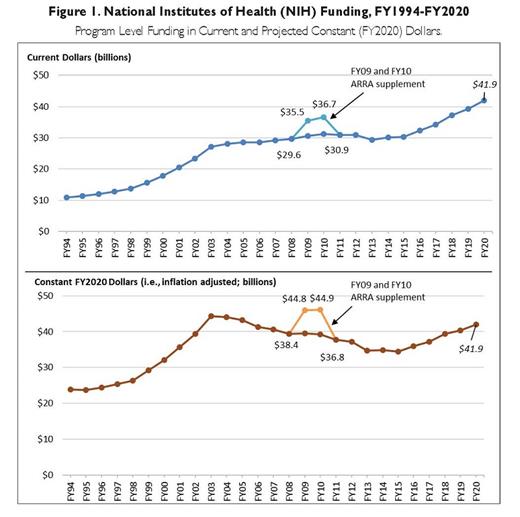During the Fall of 2018 I was getting really worried. Despite submitting numerous grant applications, nothing was being funded, and I could glimpse the need to winnow down my research staff in the not-too-distant future. I was already making some shifts to conserve funds, much as a cell goes into starvation mode and shifts its metabolism, to try to survive until times got better. And then I received a couple of email notices telling me that grants had been funded. Just like that, I went from the depths of despair into the sweet light of a few more years of guaranteed funding. But it was a powerful reminder about what it would feel like to not have research funding. I know many colleagues who are facing the same unpleasant situation right now, and with a poor prognosis for any particular grant application, there’s little I can honestly say that’s reassuring.
Source: Congressional Research Service. National Institutes of Health (NIH) Funding: FY1994-2020. https://fas.org/sgp/crs/misc/R43341.pdf
Source: Congressional Research Service. National Institutes of Health (NIH) Funding: FY1994-2020. https://fas.org/sgp/crs/misc/R43341.pdf
The National Cancer Institute just announced that their 2020 funding level for R01s will increase from the 8th percentile to 10th percentile for new grants and competitive renewals and to the 15th percentile for early-stage investigators. The National Heart Lung and Blood Institute’s 2020 funding pay lines are at the 16th percentile for R01 grants and the 26th percentile for early-stage investigators. While other Institutes have not yet released their numbers, the numbers we do know are better than those in recent years; but most National Institutes of Health (NIH) applications still will not be funded. Given the effort it takes to write an NIH application, these success rates are extremely discouraging. ASH is continuing its Bridge Grant program for investigators who are revising and resubmitting NIH grants, to try to retain hematology investigators. ASH has distributed more than $17 million through the program since its inception, with more than 70 percent of the recipients subsequently being awarded an R01 from NIH within three years. Foundations and other funding sources such as the Patient-Centered Outcomes Research Institute (PCORI) continue to support research but are also highly competitive. While we should celebrate the recent consistent increases in the NIH budget, the reality is that we are still below the buying power of 2003, and the drought from 2003 to 2015 (Figure) has probably forced many people to leave research and discouraged others from even trying to pursue a research career. I don’t have any hard data to back up my assertions; I’m just reporting the anxious pulse I feel of fellows and faculty who don’t see a path to enter or remain in academic research.
This issue of The Hematologist is filled with articles describing advances in our understanding of hematology and improvements in care, built upon solid basic and clinical research conducted by hematologists. ASH continues to lobby for consistent and robust research funding to keep the pipeline of breakthroughs gushing. If it takes years or decades for research to reach the prescription pad and for young investigators to reach their peak of productivity, then the effects of a 12-year dry spell may not be felt for another decade. It is important that legislators and the public be reminded that their investment in research is long-term, but the payoffs are potentially huge. So if you are conducting funded research and giving a presentation or an interview, please make sure that you not only thank your funding sources (e.g., “I’d like to thank my funding sources for their support”) but that you explicitly tell your audience, “…without which, this work would not have been possible.”

